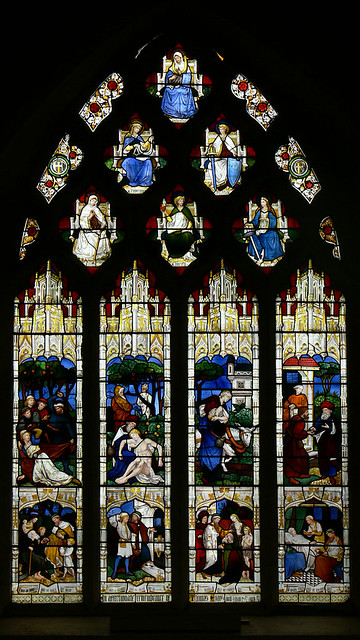Good Samaritan - Lutterworth, Leicestershire
Submitted by walwyn
This stained-glass window is the Good Samaritan Window at St Mary’s Church, Lutterworth, Leicestershire, designed and made by the firm of Burlison & Grylls, one of the foremost English stained glass studios of the late 19th century. It’s a fine example of their narrative and theological craftsmanship within the Gothic Revival tradition.
Dated 1869 this large four-light stained-glass window depicts the Parable of the Good Samaritan (Luke 10:30–37), one of Christ’s most beloved teachings on compassion and neighborly love. It is a prime example of Burlison & Grylls’ narrative clarity and theological depth, designed to both instruct and inspire through vivid biblical storytelling.
The parable begins in the first light with a traveller from Jerusalem to Jericho being ambushed by thieves. The attackers are shown in violent motion, stripping and beating the man, leaving him half-dead on the roadside. Deep blues and crimsons dominate this panel, symbolizing suffering and sin. Second Light A priest walks past the wounded man without stopping to help. His fine robes and aloof posture contrast sharply with the suffering of the traveller. The message is clear: religious observance without compassion is hollow. In the third light the Good Samaritan kneels beside the injured man, bandaging his wounds. This is the heart of the story and the window’s emotional and spiritual center ad Burlison & Grylls depict the Samaritan with calm tenderness, his gentle expression illuminated by a halo-like glow of light. Behind them stands the Samaritan’s donkey, ready to carry the man to safety. In the forth light the Samaritan arrives at an inn, entrusting the wounded man to the care of the innkeeper. He pays for the man’s lodging, promising to return, a symbol of ongoing responsibility and selfless generosity. This act completes the parable’s moral arc: love expressed through merciful action.
Below each light are smaller subsidiary panels (predella scenes) depicting acts of healing or mercy by Christ, visually linking the Samaritan’s compassion to Christ’s divine love. Feeding the hungry, Sheltering the stranger, Clothing the naked, and Visiting the sick.
Victorian stained glass often aimed to teach as well as beautify. This window is not only a narrative illustration but a Christological allegory where The wounded traveller = Fallen humanity, The robbers = Sin and evil, The priest and Levite = The failure of the Law, The Samaritan = Christ, who heals the wounded soul, The inn = The Church, where healing continues through the sacraments, The two coins = Scripture and Grace, or Baptism and Eucharist. Through this lens, the window becomes a vivid image of redemption and divine compassion.
